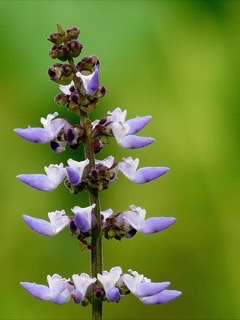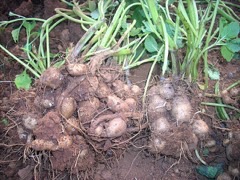 |
|
Jeevan Jose commons.wikimedia.org |
 |
| commons.wikimedia.org/wiki/User:Manojk |
Translate this page:
Summary
Physical Characteristics

 Plectranthus rotundifolius is a PERENNIAL growing to 0.6 m (2ft) by 0.4 m (1ft 4in) at a fast rate.
Plectranthus rotundifolius is a PERENNIAL growing to 0.6 m (2ft) by 0.4 m (1ft 4in) at a fast rate.
See above for USDA hardiness. It is hardy to UK zone 10. The flowers are pollinated by Insects.
Suitable for: light (sandy), medium (loamy) and heavy (clay) soils. Suitable pH: mildly acid, neutral and basic (mildly alkaline) soils. It can grow in semi-shade (light woodland) or no shade. It prefers moist soil.
UK Hardiness Map
US Hardiness Map
Synonyms
Calchas parviflorus (Benth.) P.V.Heath. Coleus dysentericus Baker. Coleus pallidiflorus A.Chev. Coleus parviflorus Benth. Coleus rehmannii Briq. Coleus rotundifolius (Poir.) A.Chev. & Perrot. Coleus rugosus Benth. Coleus salagensis Gürke. Coleus ternatus (Sims) A.Chev. Coleus tuberosus (Blume) Benth. Germanea rotundifolia Poir. Majana tuberosa (Blume) Kuntze. Nepeta madagascariensis Lam. P. coppinii Heckel. P. ternatus Sims. P. tuberosus Blume. Solenostemon rotundifolius (Poir.) J.K.Morton.
Plant Habitats
Edible Uses
Edible Parts: Leaves Root
Edible Uses: Condiment
Hausa Potato Tubers are eaten raw or cooked [301 ]. They are often eaten as a relish in combination with starchy staple food, but occasionally they constitute the staple food [299 ]. They are cooked with spices in various combinations with other foods such as beans and cooked vegetables [299]. They are eaten cooked or steamed as a vegetable, sometimes even raw; they are also mixed with savor [451 ]. Adult tubers are also used as a substitute for potatoes to prepare minced meatballs [451 ]. They are best consumed in small quantities, as they are somewhat indigestible [451 ]. Hausa potatoes are used in the same ways as potatoes typically boiled but may also be roasted, baked, or fried. Their flavour is bland but sweeter than Coleus esculentus. [46, 301 ]. Flour milling is reported in Burkina Faso. The white, starchy, slightly aromatic tubers become dark with age[451 ]. The tubers are usually 2 - 4cm long, occasionally to 8cm, occurring in clusters of 3 - 7 [299, 451 ]. Leaves are cooked and sometimes used as a vegetable [299, 300 ].
References More on Edible Uses
Medicinal Uses
Plants For A Future can not take any responsibility for any adverse effects from the use of plants. Always seek advice from a professional before using a plant medicinally.
Antidiarrhoeal Cancer Dysentery Ophthalmic
The leaves are used in traditional medicine for purposes such as the treatment of dysentery [299]. The plant is also used to treat blood in the urine and eye disorders [299]. It possibly has anti-cancer properties [1-4].
References More on Medicinal Uses
The Bookshop: Edible Plant Books
Our Latest books on Perennial Plants For Food Forests and Permaculture Gardens in paperback or digital formats.

Edible Tropical Plants
Food Forest Plants for Hotter Conditions: 250+ Plants For Tropical Food Forests & Permaculture Gardens.
More

Edible Temperate Plants
Plants for Your Food Forest: 500 Plants for Temperate Food Forests & Permaculture Gardens.
More

More Books
PFAF have eight books available in paperback and digital formats. Browse the shop for more information.
Shop Now
Other Uses
Agroforestry Uses: Hausa potato is grown either as a sole crop or intercropped with bambara groundnut, yam, okra, millet, maize or sorghum[299]. Its cultivation has been largely displaced by the spread of cassava.
Special Uses
Food Forest
References More on Other Uses
Cultivation details
They are cultivated in tropical and subtropical Africa and Asia. A plant of the moist tropics adapted to the monsoon. It grows best in areas where annual daytime temperatures range from 17 - 27°c but can tolerate 8 - 36°c [418 ]. Lower night temperatures promote tuber development [300 ]. It prefers a mean annual rainfall in the range 1,800 - 2,600mm, but tolerates 1,200 - 4,000mm [418 ]. Plants are adapted to relatively high rainfall - the best yields are obtained in areas with rainfall well distributed through the growing season [300 ]. They require regular moisture during the summer growing season and especially when their tubers are fattening during autumn. Resist the temptation to overwater tubers when they are newly reawaken in the spring, plants progressively become more thirsty as they generate an increasing volume of foliage. Harvest in early winter. When there is too much rain, the tubers tend to branch, which consumers dislike because they are then difficult to peel [299 ]. Requires a sunny position [299, 418 ]. It prefers a well-drained sandy loam but can tolerate a range of soils [300, 418 ]. Tolerant of poorer, dry soils, though yields are lower in such conditions [299 ]. Yields are low in heavy soils [299 ]. Prefers a pH in the range 6.5 - 7.5, tolerating 5.5 - 8 [418 ]. Dislikes waterlogged soils [300 ]. Plants take 5 - 7 months from planting to harvesting the tubers[300 ]. The tubers are formed on stems that are in contact with the soil. Yields from 7 - 15 tonnes per hectare have been recorded [300 ]. The tubers need to be harvested quickly, or they are liable to decay rapidly [300 ]. Hausa potato is difficult to store. Traditionally the tubers are stored in the ground under a tree where it is cooler than in the open. When stored in this way under hot conditions, the special taste of Hausa potato usually lasts for two months only, after which the tubers become bland and are no longer considered a delicacy [299 ]. Hausa potato is also packed in bags or baskets stuffed with straw, but if these are kept under warm conditions, the tubers will soon shrivel and are no longer edible. To keep the tubers longer, people put them in pots sealed with cow dung. The small tubers needed for the next planting season are stored in this way. In cooler conditions, such as in highland regions of South Africa, storage is easier[299 ]. There are some named varieties[300 ]. Plants wither and become dormant, and die down during the cool season. Hausa potato can be easily grown in soil or containers and often grown as an annual crop especially in more temperate areas. Leaves are slightly oily and aromatic, giving a peculiar aroma that resembles black pepper.
References Carbon Farming Information and Carbon Sequestration Information
Temperature Converter
Type a value in the Celsius field to convert the value to Fahrenheit:
Fahrenheit:
The PFAF Bookshop
Plants For A Future have a number of books available in paperback and digital form. Book titles include Edible Plants, Edible Perennials, Edible Trees,Edible Shrubs, Woodland Gardening, and Temperate Food Forest Plants. Our new book is Food Forest Plants For Hotter Conditions (Tropical and Sub-Tropical).
Shop Now
Plant Propagation
Seed - not normally used for propagation[300 ]. Cuttings about 10 - 20cm long[300 ]. They can be difficult to root[300 ]. Division of sprouting tubers[300 ]. They are planted about 5 - 8cm deep[300 ].
Other Names
If available other names are mentioned here
Hausa Potato, Native potato or country potato in Africa and Chinese potato in India. Coleus; coleus potato; Kafir potato. Sudan potato, Zulu potato, pomme de terre de Madagascar, ngaboyo, fabirama, fabourama, pesa, pessa, tumuku, fabirama, usu ni g', usu ni fin, peinssa, kentang hitam, kentang ireng, kleci, ubi keling, ubi kemili, Africa: frafra potato. India: Kurka. Thailand: Man Khee Nuu (Songkhla); Man Nuu (Nakhon Si Thammarat). Sometimes referred to as a 'lost crop of Africa'.
Native Range
Coming Soon
Weed Potential
Right plant wrong place. We are currently updating this section.
Please note that a plant may be invasive in one area but may not in your area so it's worth checking.
None Known
Conservation Status
IUCN Red List of Threatened Plants Status : Least Concern.

Growth: S = slow M = medium F = fast. Soil: L = light (sandy) M = medium H = heavy (clay). pH: A = acid N = neutral B = basic (alkaline). Shade: F = full shade S = semi-shade N = no shade. Moisture: D = dry M = Moist We = wet Wa = water.
Now available:
Food Forest Plants for Mediterranean Conditions
350+ Perennial Plants For Mediterranean and Drier Food Forests and Permaculture Gardens.
[Paperback and eBook]
This is the third in Plants For A Future's series of plant guides for food forests tailored to
specific climate zones. Following volumes on temperate and tropical ecosystems, this book focuses
on species suited to Mediterranean conditions—regions with hot, dry summers and cool, wet winters,
often facing the added challenge of climate change.
Read More
Expert comment
Author
(Poir.) Spreng
Botanical References
Links / References
For a list of references used on this page please go here
A special thanks to Ken Fern for some of the information used on this page.
Readers comment
| Add a comment |
|
If you have important information about this plant that may help other users please add a comment or link below. Only comments or links that are felt to be directly relevant to a plant will be included. If you think a comment/link or information contained on this page is inaccurate or misleading we would welcome your feedback at [email protected]. If you have questions about a plant please use the Forum on this website as we do not have the resources to answer questions ourselves.
* Please note: the comments by website users are not necessarily those held by PFAF and may give misleading or inaccurate information.
To leave a comment please Register or login here All comments need to be approved so will not appear immediately.
|
Subject : Plectranthus rotundifolius
|
|
|
|